Do volcanic eruptions happen underwater?
Underwater volcanic activity is a constant process that shapes the features of the ocean.

An area on the summit of the West Mata Volcano erupting in 2009. Image courtesy of NOAA / NSF / WHOI. Download image (jpg, 96 KB).
Submarine volcanic eruptions are characteristic of the rift zones where crustal plates are being formed. These rift zones, which are found in all of the Earth’s major ocean basins, are known as seafloor spreading centers because they are places where tectonic plates are moving away from each other. Most seafloor spreading centers lie at depths exceeding 2,000 meters (1.2, miles) and, as a consequence, approximately three-quarters of all volcanic activity on Earth occurs as deep, underwater eruptions. The effects of these deep eruptions cannot be seen from the surface of the ocean.
Spreading center eruptions typically produce a rock called basalt, which is the principal rock that makes up oceanic crust. Although these eruptions can be locally violent, the style of eruptions can result in the deformation of the Earth’s crust, closely resembling the eruptions of Hawaiian volcanoes.
Submarine basalt flows often have a distinctive “pillow” shape but can exhibit flow types characteristic of basalt eruptions on land, including smooth sheet flows.
Submarine eruptions occur along all seafloor spreading centers, but they are most commonly along spreading centers where the plates are moving apart at relatively rapid rates. Spreading rates generally vary between 1-2 centimeters (0.4-0.8 inches) per year at places like the Mid-Atlantic Ridge to 10-15 centimeters (4-6 inches) per at seafloor spreading centers such as the East Pacific Rise.
Submarine eruptions can also occur in places where crustal plates collide and one plate progressively dives beneath the other and is ultimately remelted. In such regions, known as subduction zones, the style of eruptions is dramatically different from those along spreading centers. The rock type typical of subduction zone volcanism is andesite, which is a product of the melting of the plate being subducted. Andesitic lavas, because of their high viscosity and high gas content, typically produce violent eruptions. Active deep andesitic eruptions have only recently been discovered and observed. They are only approachable because their explosiveness is dampened by the depths at which they occur.
A third type of submarine eruption occurs as a consequence of a magma plume rising through the Earth’s crust overlying an area of melting in the Earth’s mantle. These eruptions are known as hotspot volcanoes and they often form chains of volcanic islands and seamounts that are older with increased distance from the surface location over the rising magma plume. The rock type characteristic of hotspot eruptions is basalt.
Submarine volcanoes are also interesting because of the unique habitats they create. Seamounts are often areas of high biological diversity; their shape acts to deflect food-carrying currents upward, attracting a variety of sessile fauna and the crustaceans and fish that feed upon them. In the late 1970s, scientists were shocked to discover that some animals can even metabolize inorganic compounds emitted during volcanic activity, forming unique communities around areas of hydrothermal venting (similar to geyser activity on land).